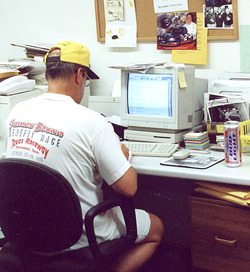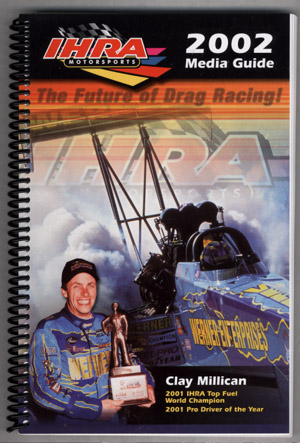 photo by Jeff Burk
photo by Jeff Burk
|
When I was a teenager and hanging out at the local Bob's Big Boy in
Toluca Lake, Calif., the topic in the lot was almost always girls, cars,
and records. I was strong on two of the three topics, and one of those
was drag racing. I was about 15 or 16 at the time and there was a guy
I always evesdropped on because he sounded like he knew a lot about
drag racing. (You didn't think it would be girls on my part. Hell, I
thought "vagina" was a state directly above North Carolina back then.)
Still do. He could drop the names. Garlits, Ivo, the then unpronounceable
Karamesines, Safford, Prudhomme, Bill Martin, Tony Nancy, and Art Malone.
The guy's name was Jerry Sayduh, and all I remember about him 40 years
later was that he was fairly knowledgeable and that he had a bum leg.
However, he inspired me. I was younger than all my friends, so I never
got to touch a tool when they were working on their cars. I figured
the only way I could establish myself in the Bob's Big Boy street racing
scene was to sound like I knew what I was talking about. So, when I
went to the drags for the first time in June of 1963, I made it a point
to remember what I saw. I liked Sayduh's style and I thought there was
room for two people like him. For the next two years, I read every issue
of Drag News, National DRAGSTER, and Drag Sport Illustrated I could
find, went to as many races as I could, and by the time I was graduating
high school in 1965, I was one of the "know-it-all" guys at Bob's Big
Boy ... as small and as inconspicuous as I was. I knew more about it
than probably anybody in the local class of 1965 high schools, and I
could hold my own with the veterans, those approaching or just passing
by 21 years of age.
Today, it's a lot different, if I my trivia instincts tell me anything.
For the past quarter century, the title series sponsors have produced
media guides for the working and even the non-working press in my case.
NHRA and Winston came out with the first one in 1981, a small pocket-size
book that later expanded from its initial 60 to 70 pages to a 2001 guide
that weighed in at a whopping 420 pages.
The first IHRA guide that I ever saw came out a few years later in
1983 and checked in at a thin 62 pages. The 2002 IHRA guide currently
stands at a humble 172 pages.
What does this all mean?
Well, if you want to become a drag racing expert, it's a lot easier
now than it was 40 years ago or even 20 years ago. You don't have to
go combing through used book stores for back-issue magazines or newspapers,
but instead be lucky enough or hustler enough to get in an NHRA or IHRA
press room and snatch one of these babies.
Believe me, overall, it's worth it to make a friend of a drag racing
presser through a bribe or better to get one of these books; you do
learn a lot.

What inspired this exit at the off-ramp was that I received the IHRA
media guide from the Burkster, and since drag racing results and numbers
are a big deal to me, I thought I'd review it for all you stats-o-philes.
Let you know if you could pick this thing up and come away an expert
on all things IHRA.
As to the answer, I'd give a very qualified yes.
If I could make a general conclusion about it, the IHRA media guide
2002 is strong in terms of knowing who won what and who beat whom. It
does a good job on its top 10 Pro finishers' biographies, but it falls
down noticeably in the area of elapsed times and miles per hour.
Current IHRA Pro Stock champ Gene Wilson is a good example of all the
above. I recall him as just one of the contenders when I went to the
IHRA show two years ago at Cordova Dragway Park. Then recently, I saw
him in the NHRA qualifying stats at, I think, the 2002 Gatornationals
or Houston race. The IHRA guide informed me that his making the show
was no accident; the guy tied Bob Glidden's IHRA single season win mark
at nine. He was the 2001 IHRA Pro Stock champion. Not only that, but
the kid's father is Orlando Wilson, the famed TV fisherman and his whole
act is first class. The point being: Small wonder that his car runs,
even in NHRA trim.
What was missing, though, in the IHRA Pro Stock top 10 biog was how
fast the car went. What was his best elapsed time and speed, and what
races did he win in 2001? Was there a material basis for going "WOW"
at Wilson's accomplishments, meager as they might appear to some? Yep.
If you checked the old NHRA/Winston guides (I haven't see the POWERade
power pack yet), you could go to the listing for Bruce Allen in 2000
as an example, and find out that he had 12 national-event wins in 32
final-round appearances, that he was O for 1 in 2000 NHRA finals and
that he had run a 6.839/200.80 best as of December 2000. Also listed
are the races where he final-ized and won or lost, the first entry being
the 1985 Springnationals where he came in second. This, coming at a
time when he was replacing the late and brilliant Lee Shepherd at the
wheel of the Reher & Morrison Camaro. The reader also gets where he
qualified and with what e.t., and where he finished up in eliminations
during the 2000 season.
You don't get that in the IHRA book, and yes, if you're a stats hound,
a hardcore fan, you want that.
IHRA's book falls down in that department in all of its Pro categories.
In the case of Wilson, the only way I could find out what was his best
time was to go to the national event track directory and look at the
track records. Sure enough, Gene Wilson's 6.532/213.37 at Maryland Int'l
Raceway appears to be his best run in IHRA national-event competition.
The reader shouldn't have to go to that extent. Do it like NHRA and
list it below the driver.
If I wanted to know what IHRA's No. 10 Pro Stocker driver Tim Nabors'
best effort was, I'd be S.O.L.
And it doesn't do any good to just look at the national records page.
First of all, using Pro Stock as an example, there can be at the most
only two drivers listed and THOSE records may not be the best times
in the class or for the driver. For example, Top Fuel driver Shirley
Muldowney's 319.22 at the 2000 IHRA Summer Nationals was the best speed
of that year, but was not backed for an IHRA record.
I know IHRA must be soooo damned tired of being compared to NHRA, but
in terms of the media guide, they should copy it. It would teach people
plenty about IHRA drag racing, certainly more than they get now.
One final note on the IHRA media guide. Last year, cover guy Clay Millican
ran off six straight national event wins. I don't care what hot rod
association you're running, six straight against fair competition is
noteworthy and would be better served if listed (ala the NHRA media
guide) under the top 10 finisher's name.
As it is in the current media guide, one has to go to the IHRA National
Event History section and look up each race to see that, indeed, Millican
rattled off wins at the Amalie Oil Summer Nationals, the CARQUEST Auto
Parts Empire Nationals, the CARQUEST Northern Nationals, the Mopar Parts
World Nationals, the Amalie North American Nationals, and the CARQUEST
Auto Parts Autumn Nationals.
All well and good, the runner-ups were included with one notable M.I.A.
Where were the final-round times as they were listed in previous IHRA
record books, at least those during the Winston and Summit eras? I've
long been an admirer of Milllican crew chief Mike Kloeber's work and
would've liked to see what he threw at the competition in that skein.
Also, somewhere in the media guide, some attention should be focused
on the great times in the organization. You fans know that IHRA was
the backdrop for the first hot rod association six- and seven-second
elapsed times, as well as the first 170, 180, 190, and 200 mph times.
Why isn't that broadcast to the world in their media guide? Where is
the section that shows IHRA's great e.t.s and mphs from the organization's
birth in 1971 to the present?
Don't think it's important? Then take down the top end scoreboards.
Still, all in all, if the year was 1964 and a young aspiring drag racing
expert named Chris Martin wanted to learn about a mythical (at-that-time)
IHRA, this book would start the ball rolling, but not all that far.
Oh, by the way, if IHRA would like to clean up and bolster the 2003
IHRA media guide, I know a guy in Valley Village, Calif., who could
do that for a reasonable sum of cash.
Next column? The NHRA Media guide and various and sundry items.
|